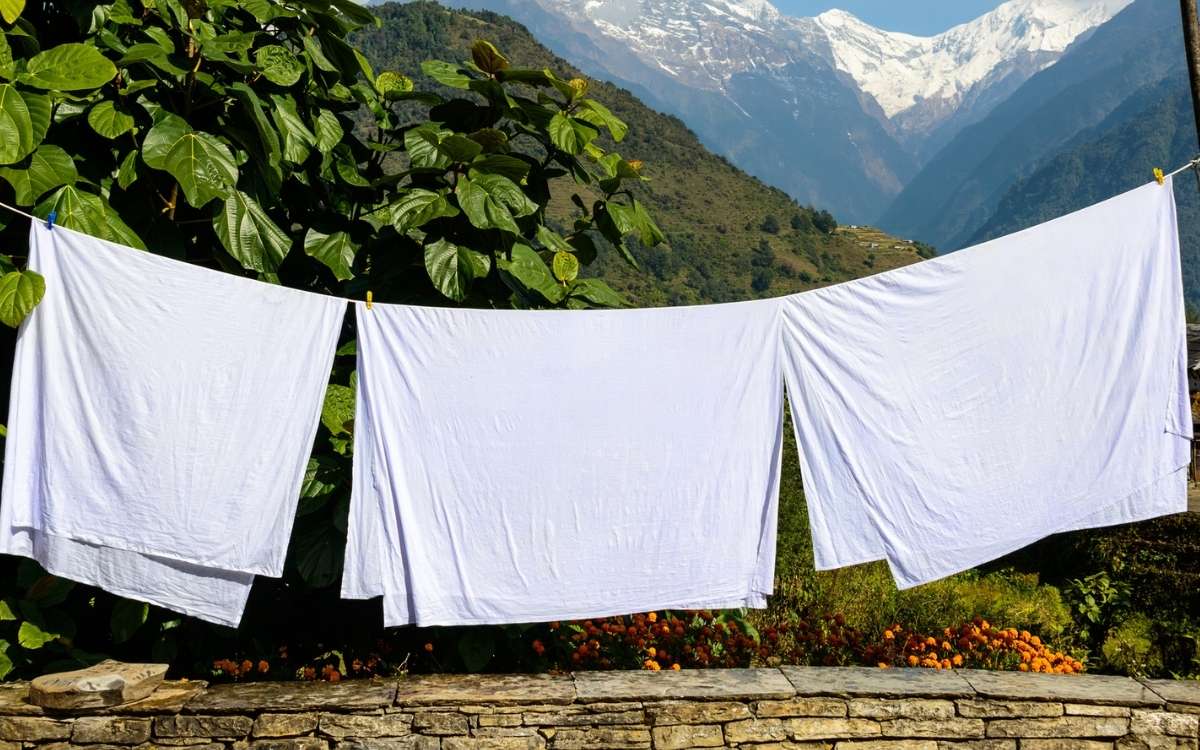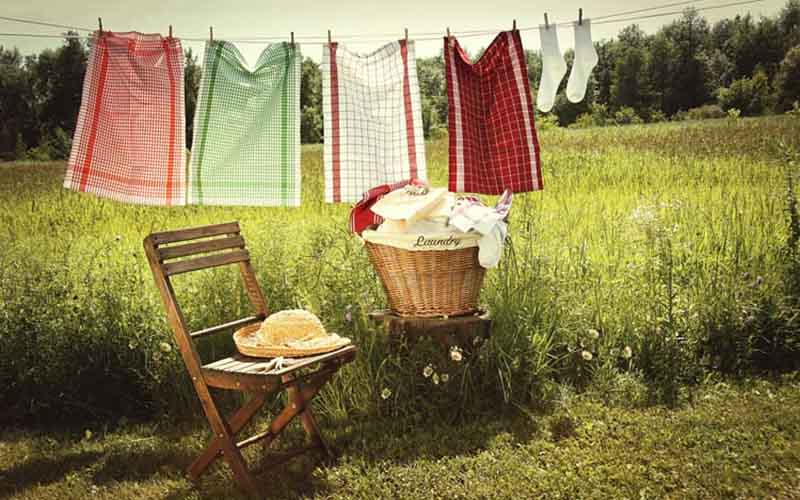Drying bed sheets without a dryer might not be the most convenient option, but it is certainly an effective one for those who don’t own a dryer or are looking to reduce their utility costs.
There are many ways to get your sheets and linens dried without turning on the dryer. Make sure to choose a method that allows the moisture in your sheets to dry quickly in order to avoid mildewing.

Here are 8 different drying methods that you can use that will save you money and provide you with great results.
Table of Contents
How to Dry Bed Sheets Without a Dryer: 8 Ways
If you want to know how to dry a comforter without a dryer or how to dry bed sheets without a dryer, you only need to look around and see what you have on hand. These 8 drying tips are easy to do and require very few supplies.
1. Hang Them Up
The most basic way to dry sheets is to hang them somewhere in your home. You will want to make sure that your bedsheets can be fully spread out and exposed to the air in order for them to dry quickly.
Placing them near a window will help them to dry quickly due to the support of the sun.
Hanging sheets over furniture, doorknobs, shower rods, or even banisters. This is a great way to make use of your indoor space when you want to avoid drying bedsheets outside in the rain.
Make sure that you don’t place your sheets over any items that are delicate to moisture, such as unfinished wooden furniture. You may end up with water stains or even warped furniture.
You’ll also want to avoid draping your sheets in fabric such as your bed or sofa. The fabric will absorb the moisture from your sheets and then start to grow mildew if it is not dried quickly enough.
2. Line Dry Outside

Line drying is one of the easiest and most effective ways to dry your sheets.
You can hang them on a clothesline or use wooden pins, which you can either purchase at a home improvement store or make yourself by cutting pieces from wood dowels.
There are many new variations on clotheslines that make drying your sheets very easy and efficient. You can find retractable clotheslines that allow you to pull out as much or as little line as needed, making it easy for setup and takedown.
Another option is the rotary clothesline, which allows you to rotate the lines so that all sides of each item are exposed to the sun equally.
The sun is a very powerful force that can disinfect and dry your sheets quickly, making this option a good one. The wind also helps to soften the fabric and prevent it from drying too stiff.
Make sure you take your bed sheets down before you go to sleep, or else you may wake up to wet sheets covered with morning dew.
3. Place a Fan Nearby
A fan can be used to help speed up the drying process. Set your fan on a low setting and point it upwards towards where you are hanging your sheet.
You can adjust the fan every 10 to 15 minutes so that it evenly dries your sheets. Oscillating fans are also a great option because they can move in different directions, allowing for even drying.
When using a fan to dry sheets, you will want to make sure to keep a good distance between your sheet and the fan, to make sure that the sheet doesn’t get caught in the blades. If it does, you may end up with a shredded sheet that will need to be replaced before being used again.
Overhead fans are also helpful when drying sheets. If you have a ceiling fan that swivels, then turn it on to increase airflow.
4. Use Towels
You can dry your sheets by using towels and transferring the moisture from one to the other. Place your sheets on top of a few towels and then roll them up as tightly as possible.
Apply pressure in any way possible that can wring the water out of them. Go ahead and sit on them. You can also lay them flat on your floor and then use weight (such as books) placed evenly across the rolled towel to help transfer moisture from one side to another.
When you unroll it, moisture from the sheet will be transferred onto the towel and help it dry faster than if left alone. You can repeat this process with a new dry towel to get additional moisture out of your sheets.
This is a great option for those with limited space, or who don’t want to hang their bedsheets up outside in the cold weather.
5. Buy a Drying Rack

You can purchase a drying rack to help speed up the process of drying bedsheets. These drying racks work by allowing air to flow between each sheet and towel so they dry quickly without mildewing.
They also allow for sheets to dry evenly on both sides. This is especially helpful if you are drying heavier sheets or bedding so that they have good and even air exposure.
You can find drying racks in many different materials, including plastic, wood, bamboo, and metal, depending on your personal preference.
A drying rack is a great option for those who don’t have the space or time to line-dry their sheets inside or outside. They can fit in a small space and can hold a surprising amount of bedding and clothing.
Many of them are also collapsible, making them easy to store when not in use.
6. Use a Hairdryer
A hairdryer uses a lot of energy and would take a long time to completely dry a bedsheet, but it’s a great option if your bed sheet is still damp and you want to use it right away.
Make sure the heat setting is on low or you could damage your sheet, and keep a good distance between the hairdryer and bedsheet to prevent burning.
When using this method, be careful not to touch anything, since your bedding can warm up quicker than you expect and may be too hot to the touch.
This option works best for those who are in a rush and only need to dry a few wet patches, but it still produces good results.
7. Place Your Sheets Near a Heat Source
You can put your sheets near a radiator, fireplace, heater vents, or anything that emits heat. This will help your sheets dry much faster than if they were hanging in a cool area of the room.
Be careful to make sure that the heat source isn’t too hot or you could end up damaging your sheets.
This is a great option if you have access to these types of heating units in your home, but it can also be dangerous. Make sure to keep an eye on your sheets if you use this method.
8. Use a Towel and Iron
You can use your iron to dry your wet bedsheets as long as you use a towel as a buffer and to help absorb excess moisture. Place your wet sheets on your ironing board and then place a towel on top of them.
Set your iron to high and firmly press down on the towel to help transfer and evaporate moisture from your bedsheets into it. Keep pressing until you cannot see any more water being transferred or soaked up by the towel.
This is a great option for those who have access to an iron and dryer, but this method takes some time, so be patient if you use it.
Final Thoughts
As you can see, there is a method for drying your sheets without a dryer for every budget, environment, home size, and time allowance.
Keep in mind that the simplest option is usually the best, and opt to line-dry or hang your sheets outside whenever possible.
If you have to use a different method, make sure to take safety precautions if necessary and always be patient when waiting for your bedsheets to finish drying!

